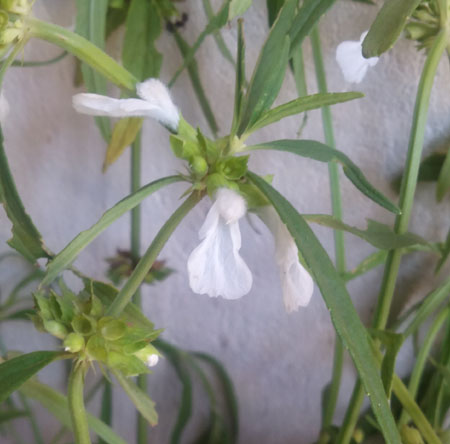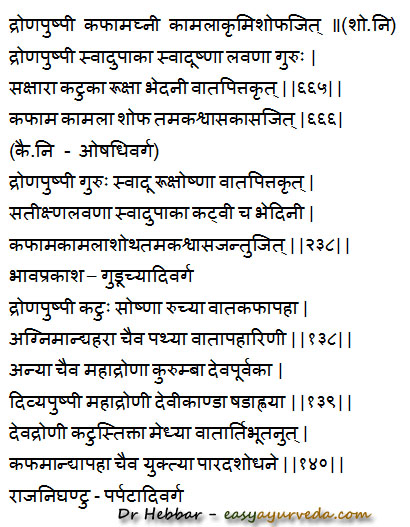Dronapushpi- Leucas cephalotes: Uses, Dosage, Side Effects
Dronapushpi – Leucas cephalotes is a famous Ayurvedic herb, also used in Hindu religious practices. It is widely used in treating liver disorders, jaundice, asthma, cough, cold etc.
Botanical Name- Leucas cephalotes (roth) spreng
Family- LAMIACEAE (Tulasi kula)
Table of Contents
Vernacular Names
Hindi Name- Guma
Telugu Name- Tummi, Peddatumani
Bengali Name- Dandakalas, Halaksa, Ghalghase
Marati Name- Tubari, Tumba
Gujarati Name- Kubo
Tamil Name- Tumbari, Thumbai
Kannada name – Tumbe, Tumbe hoovu, Tumbe gida, Thumbe
Malayalam name – Tumba, Tumba Poovu

Sanskrit Synonyms
Dronachatra, Drona, Drona Kurambaka, Dronapushpa – boat shaped flowers
Kutumbaka, Kaundinya, Kshavapatra, Chatrini, Chitrakshupa, Phalepuspa, Guma, Nahula, Kumbhayoni,
Chitrapatrika
Phalepushpa – Fruits and flowers are arranged together
Kshavapatra – Leaves because of its strong odor , induce sneezing
Vrushasara, Shwasanaka – useful in respiratory conditions
Deerghapatra – lengthy leaves
Varieties, distribution
Raja Nighantu explains two varieites of Dronapushpi.
Dronapushpi – Leucas aspera
Maha Drona – Leucas cephalotes.
Another species L. Indica(L) R. Br. Ex Vatke (Leucas lavandulifolia smith; Leucas linifilia (Poth) Spreng; Leonurus indices Linn) is also being used as Dronapushpi.
Distribution- Commonly found throughout India and China.
Classical categorization
Bh. Pr. Ni – Guduchyadi varga
Chemical constituents
Leucas cephalotes Chemical Constituents
Laballenic acid, B- Sitosterol and its glycoside
oleanolic acid, 7-oxositosterol, 7-oxostigmasterol, 7alpha-hydroxy stigmasterol, stigmasterol, 5-hydroxy-7,4′-dimethoxyflavone, pillion, gonzalitosin I, Tricin, cosmosin, apigenin-7-O-beta-D-(6-O-p-coumaryl) glucopyranoside, anisofolin A and luteolin.
Medicinal properties
Leucas cephalotes medicinal Properties-
Rasa (taste) – Katu (pungent)
Guna (qualities) – Guru (heaviness), Rooksha (dryness)
Vipaka- Katu – undergoes pungent taste conversion after digestion.
Veerya- Ushna – Hot potency.
Effect on Tridosha – Kapha Vata Hara. Balances Kapha and Vata.
According to Bhojana Kutuhalam twelfth chapter, Dronapushpi is pungent in taste, hot in potency, appetizing in nature,treats vomiting and vitiated kapha dosha. It checks weak digestive fire, is wholesome for the body and alleviates vata dosha.
The leaves of dronapushpi are sweet, dry, heavy and alleviates pitta dosha. It loosens the feces, treats jaundice, edema, prameha, fever and is pungent in taste.
Part used, dosage
Part Used- whole Plant, Leaves, Flowers
Dosage- Fresh juice 10-20 ml
Sanskrit verse

Medicinal uses
Dronapushpi – Leucas cephalotes medicinal uses
Kshara – has properties of Kshara – able to scrape the sputum out, cutting, scraping in nature.
Kaphahara – Balances Kapha Dosha, removes excess sputum.
Amahara – relieves Ama – a state of disturbed digestion and metabolism
Kamalajit – Useful in jaundice
Jantujit, Krumijit – useful in worm infestation, infected wounds,
Shophajit – Reduces swelling, anti inflammatory
Bhedani – piercing,
Tamakashwasajit – Relieves asthma
Kasajit – relieves cough, cold
Ruchya – improves taste, relieves anorexia.
Agnimandyahara – Relieves indigestion, low digestion strength
Useful in amenorrhea, oligomenorrhea.
Useful in Jwara of Vata and Kapha – with pain, heaviness, coldness, stiffness, associated with cold, cough etc.
For sinusitis and headache:
Dronapushpi’s fresh leaves are crushed to extract juice. Two drops of this juice are put into both nostrils on an empty stomach. This helps to relieve sinusitis related headaches.
For wound cleansing, the plant is dried, powdered, made into Kashaya by adding water and boiling it. This water is used to wash the wounds.
In poisoning:
In ancient times, its juice extract or leaf paste was applied over snake bite regions.
Side effects
Excess use or overdose may cause increased burning sensation.
Nasal administration of its juice extract should only be done by a qualified Ayurvedic doctor.
Safe to use in children and during lactation.
Need medical supervision to use during pregnancy.
Interaction with medicines, supplements
Can this be used while taking Homeopathic medicine?
Yes. This product does not react with homeopathic medicine.
Can this medicine be continued while taking supplements like multivitamin tablets, Omega 3 fatty acids etc?
Yes. Generally, this product goes well with most dietary supplements. However, if you are taking more than one product per day, please consult your doctor for an opinion.
With western
medicines
Seek your
doctor’s advice if you are taking this product along with other western
(allopathic / modern) medicines. Some Ayurvedic herbs can interact with modern
medicine.
If both Ayurvedic and allopathic medicines are advised together, then it is
best to take Allopathic medicine first, wait for 30 minutes and then take the
Ayurvedic medicine.
Raja Nighantu reference
Mahadroni, as per Raja Nighantu is –
Katu – Pungent taste
Tikta – bitter
Medhya – improves intelligence
Vatartinut – relieves pain due to Vata imbalance, as in case of neurological pain, injury pain etc.
Bhutanut – antimicrobial, useful in psychiatric conditions
Kaphahara –Balances Kapha, useful in excessive sputum
Parada Shodhana – Used in purification processes of Mercury.
Substitute
Leucas aspera
Leucas lavandulaefolia
Ayurvedic medicines
Ayurvedic medicines with Dronapuspi ingredient:
Gorochanadi Gulika – Used in asthma, fever.
Kombanchadi Gulika – Used in treating headache, fever, cough and cold in children.
Pleehari Vatika – used in splenomegaly, liver disorders, vomiting, dizziness etc. Dronapuspi’s juice extract is used for grinding with other ingredients, before rolling the pills.
Morphology
Annual herb
Stem – Quadrangular branched stem, Herbaceous
Leaf – opposite, lanceolate with reticulate venation
Inflorescence – Verticillaster
Flower – White, bilabiate,
Fruit – Schizocarpic, Seeds are non endospermic
Sthanika Karma (Systemic Action)
External Application – Antimicrobial, Anti poisonous, and pacifies kapha dosha. Nasya can be done with its juice in conditions like headache, rhinitis etc. Decoction is used for wound cleansing. Collyrium with its juice is indicated in Jaundice.
Internal administration –
Digestive system – Carminative, Facilitates movement of doshas in the normal direction, stimulates the release of bile from the gallbladder, purgative, Anti helminthic. Indicated in Helminthiasis, liver disorders, abdominal colic, constipation etc.
Circulatory System – Acts as a blood purifier
Respiratory system – Pacifies kapha dosha, indicated in rhinitis, breathing disorders, Cough etc.
Reproductive system –indicated in Amenorrhea, Dysmenorrhea.
Tvak – indicated in skin diseases
Tapakrama – Indicated in fever (vishama jvara, Vata pitta jvara)
Satmikarana – Anti poisonous (Animal poisoning)










